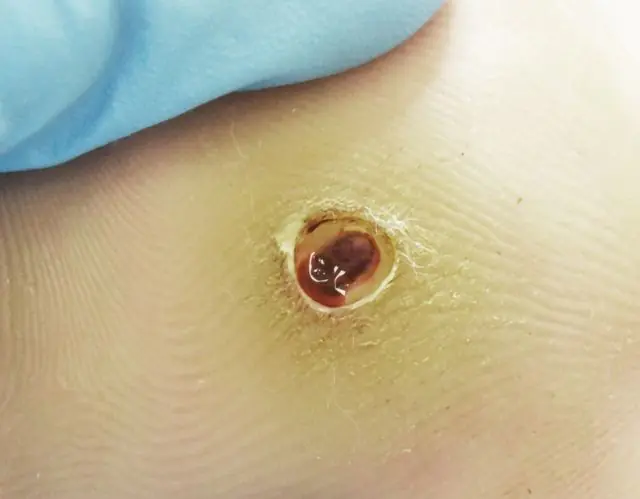
- Why did the papilloma burst?
- How to determine
- What to do if a papilloma bursts
- Medicines
- Removal of papilloma
- Prevention of injury
The pathological process when the papilloma bursts is a sign of injury to the growth and the development of the inflammatory process. This condition should never be ignored. Moreover, it is not enough to treat the wound with antiseptic agents; it is imperative to consult a doctor and find out why the papilloma burst and how to prevent further inflammatory processes. A timely visit to the doctor will help identify disorders in the early stages and prevent dangerous conditions of tissue necrosis when the papilloma turns black.
Why did the papilloma burst?
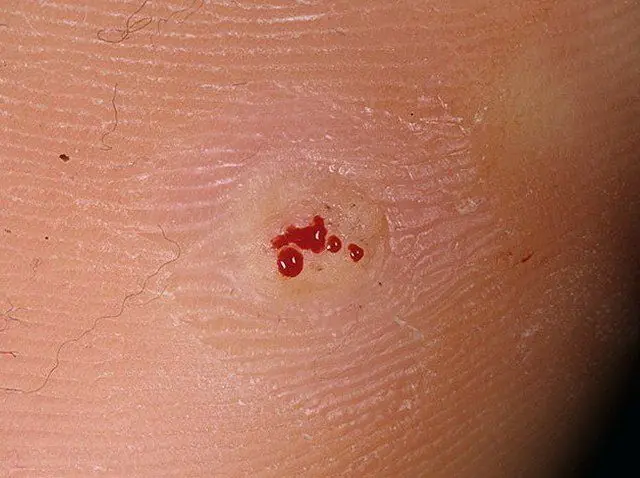
Mechanical damage to papilloma
Small lumps on the skin, which can then grow into large structures, are caused by the human papillomavirus. And if the tumor does not interfere with a person either physically or psychologically, for example, it is located on the forearm, that is, it does not interfere with movement, and is easily hidden under clothing, then the patient often does not even pay attention to his disease. However, as soon as the papilloma bursts, what to do with both the wound and the formation itself will become the main question, because such a process is associated with bleeding, discomfort and pain.
As a rule, they provoke a violation of the integrity of the papilloma mechanical damage or injurycaused by ordinary everyday activities: clothing may rub when moving, the growth may accidentally be touched, or the growth may be injured during shaving or other hygiene procedures.
Another reason why a formation may burst and bleed is its transformation into malignancy. In any case, if a papilloma has burst, you need to seek help from a specialist in order to prevent the development of the most detrimental scenarios for your health.

Photo of inflamed papilloma
This condition of the patient is complicated by inflammatory processes in the resulting wound. A number of factors contribute to the development of inflammation:
- decreased protective functions of the body caused by chronic diseases or seasonal declines;
- hormonal imbalance due to prolonged therapy;
- acute infectious diseases in the body.
An equally common reason for the bursting of a papilloma is the independent attempts of patients to remove the tumor using improvised means. Doing this is strictly prohibited, as there is a risk of aggravating the situation. Any measures to destroy skin growths should be taken only after consultation with a doctor.
- Read also why a wart blister burst
How to determine that a papilloma has burst?
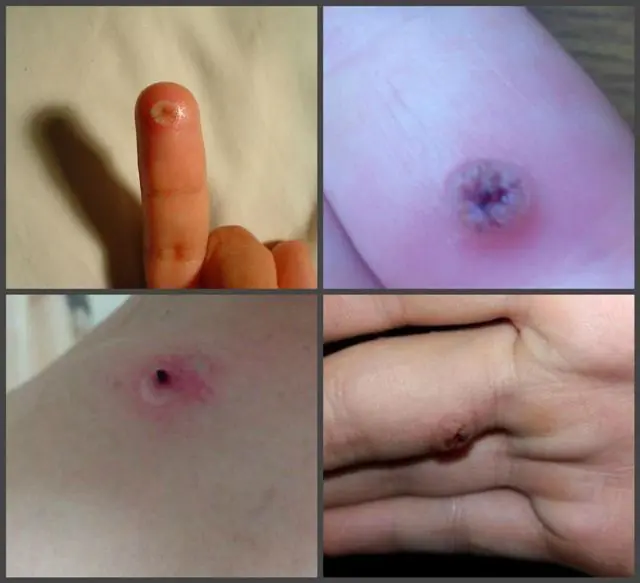
The photo shows what burst papillomas look like
It is impossible not to notice that the papilloma has burst. The symptoms of the pathogenic process are quite obvious:
- bloody discharge from the neoplasm;
- the outlines of the structure have changed;
- the formation has changed color - it has become red or brown.
At first, a person may not feel much discomfort, but as soon as inflammatory processes begin in the wound, a throbbing or aching pain and a feeling of “hot” skin will immediately appear.
As soon as it is discovered that the papilloma has burst, you should immediately consult a doctor. Ignoring the problem can lead to the death of formation cells and further spread of infection throughout the body.
What to do if a papilloma bursts?

Rupture of the papilloma significantly increases the risk of transformation of the formation into malignant one. Therefore, you should definitely consult a doctor, especially if the growth has changed color, enlarged or started to itch. If a malignant structure is detected, removal of the papilloma will be recommended.
Let us consider in detail what to do if a papilloma bursts:
- Process education in accordance with the rules of first aid for injuries;
- Contact a specialist and undergo a full examination to identify the causes of the bursting papilloma;
- Complete the course of treatment prescribed by your doctor and, if necessary, remove the tumor.
As a rule, growths and lumps on the body caused by HPV are relatively small in size and are fed by a network of small capillaries. Their injury can be roughly equated to small cuts. Taking this into account, even a schoolchild knows what to do if a papilloma bursts.
First aid is as follows:
- Rinse the wound with running water to remove any possible dirt;
- Treat papilloma with an antiseptic;
- Cover the formation with a sterile napkin and carefully fix it. When fixing the bandage, it is extremely important not to aggravate the injury to the growth.
After providing first aid when a papilloma has burst, you should visit several specialists. The therapist, having assessed the general state of health, can identify inflammatory processes in the body. A dermatologist will examine the disease and prescribe appropriate treatment. The doctor will necessarily begin to examine the body for the causes of papillomas and their inflammation. In case of hormonal imbalance, consultation with an endocrinologist will be necessary. And if a malignant tumor is suspected, a consultation with an oncologist will be required.
The next step will be to decide how to treat the papilloma if it has burst.
- Read also what to do if papilloma increases during pregnancy
Medicines for the treatment of papillomas
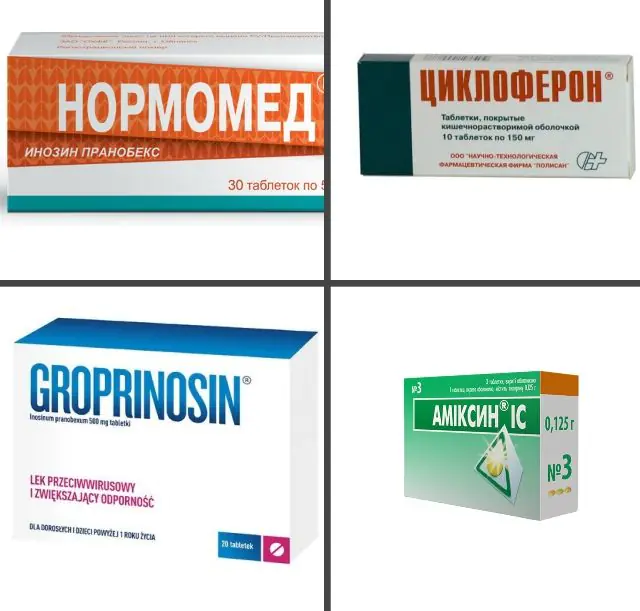
In the photo there are medications for the treatment of papilloma that has burst
Drug therapy prescribed by a doctor provides an individual approach. Treatment can only be prescribed after a series of examinations. It is mandatory to establish the type of virus that caused the formation of compactions, and also assess the general health of the patient.
Based on the results of the examinations, the following drugs will be prescribed for the treatment of papilloma when it has burst:
- Immunostimulating. Such drugs are designed to activate the body’s own protective functions. Cycloferon and its analogue Amiksin have proven themselves well. The cost of the drugs is within reason - from 150 Ukrainian hryvnia (300 Russian rubles). If necessary, the expensive Allokin can be recommended, the price of which in various pharmacies in Russia starts from 7,500 rubles (in Ukraine the cost of the drug is 2,000 hryvnia).
- Antiviral. They are prescribed to exclude the possibility of bacterial infection of the burst growth. This group includes Groprinosin and its analogues Normomed, Gropivirin, Novirin. The price range of antiviral drugs is quite wide - from 100 to 800 Ukrainian hryvnia (300-2000 Russian rubles) depending on the product and manufacturer.
Additionally, if the papilloma has burst, it will be recommended taking multivitamin complexes — Undevit, Vitrum, Multimax or their analogues, depending on the needs of the patient’s body. The cost of such drugs starts from only 59 Russian rubles (13 Ukrainian hryvnia), depending on the complex.
To enhance the effectiveness of drug therapy, it is necessary to avoid stress, give up bad habits, and switch to a healthy lifestyle.- Read also about the drug Isoprinosine for papillomas and warts
Removing papilloma when it has burst
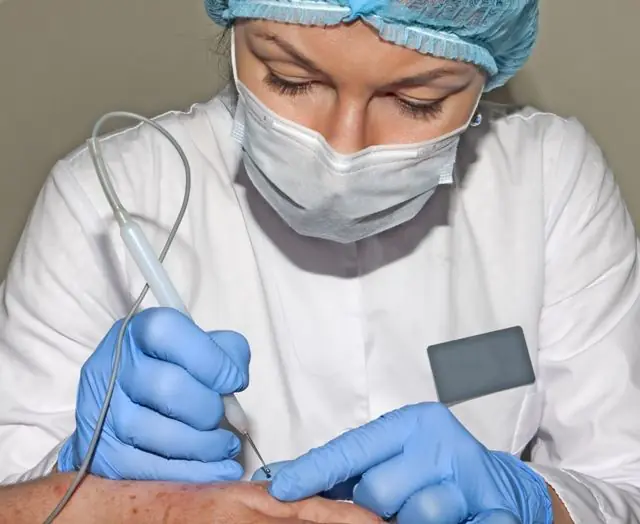
If a papilloma has burst, in most cases it will be recommended not only drug treatment, but also complete removal of the destructive formation. And in the case of malignant tissue transformation, removal will be the only possible option.
Papilloma removal is carried out in various ways:
- Liquid nitrogen. When exposed to low temperatures, the growth tissues die, but healthy tissues may also be affected during the procedure. The cost of the operation in Ukraine starts from 300 hryvnia, and in Russia - from 900 rubles.
- By radio waves. Removal using directed high-frequency waves. The non-contact method does not cause pain to the patient, but is very effective in removing the growth. The procedure costs 570 hryvnia in Ukrainian clinics, but in Russia the price starts at 2,000 rubles.
- Laser. Another innovative method that allows you to remove a papilloma that has burst, layer by layer. It acts precisely, without affecting nearby tissues, is practically painless, and minimizes blood loss. The price for the procedure is quite reasonable - 350 hryvnia in Ukraine (1250 Russian rubles).
- Electric shock. The method is considered obsolete and quite painful, but is still used due to its effectiveness and accessibility. The price for the procedure in Ukrainian clinics is only 320 hryvnia, and in Russian clinics it starts from 700 rubles.
- Chemicals. The formations are burned out with chemicals, but during the procedure, nearby healthy tissues may also be damaged. The method remains popular due to its accessibility; the procedure costs from 250 hryvnia (500 rubles).
- Surgical intervention. It is the only possible method in case of degeneration of a papilloma that has burst into a malignant formation. The cost of the procedure depends on the amount of work, anesthesia used and other related factors.
- Read also about wound care after removal of papilloma using the radio wave method
Prevention of injury to papillomas

It will not be possible to completely get rid of HPV in the body. After removal of the formation, the patient will have to take measures to prevent the appearance of new papillomas and injury to the remaining ones.
It is best to take precautions than to later wonder what to do if papillomas burst. Since the main cause of rupture of the formation is mechanical damage, it is necessary to avoid tight clothing and be careful with the growths, preventing them from being damaged.
You should also take measures to prevent the further spread of the disease: take care of your health, maintain your immune system, get rid of bad habits, observe personal hygiene rules (regularly change bed linen and underwear), and regularly see a doctor.
What to do if the papilloma becomes inflamed or comes off - watch the video:
The situation when a papilloma bursts is not standard and requires a prompt response from the patient. First aid can be provided at home, but a visit to the doctor cannot be postponed. A specialist will help not only eliminate the consequences of a burst formation, but also get rid of papilloma on the skin.
- Related article: Can papilloma develop into cancer?



